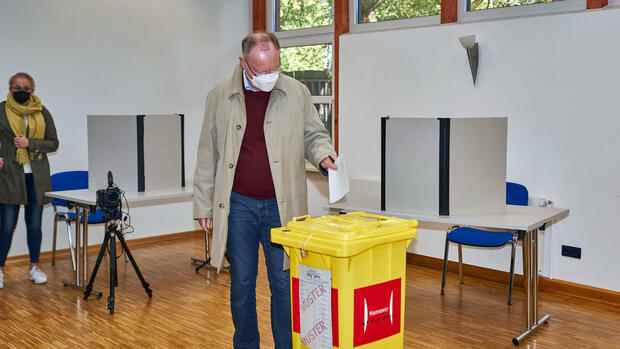The SPD politician is aiming for a third term, but hopes for a new edition of red-green.
(Photo: IMAGO/Future Image)
Hanover With the best autumn weather, the Lower Saxony made their way to the polling stations on Sunday. At 12.30 p.m. the participation in the state election was 24.59 percent, as the state election management announced on Sunday. Five years earlier, the value was slightly higher at 26.91 percent. The polling stations are open until 6 p.m.
Postal voters, many of whom are expected this year, are not yet included in the interim results. Almost 6.1 million people are allowed to take part in the election. In the 2017 election, the turnout was 63.1 percent, after 59.4 percent in 2013. The highest figure so far was 84.4 percent in 1974, the lowest was recorded in 2008 with 57.1 percent.
Prime Minister Stephan Weil cast his vote in Hanover this morning. “We hope for a strong turnout. And we hope for a strong result for the SPD,” said the SPD politician. When asked what he was going to do now, he replied: “First of all, I’m going to have a nice breakfast.”
Challenger Bernd Althusmann had already toasted in the morning. “After all, my daughter turned twelve today, which means we had every reason to celebrate this morning,” said the CDU politician when voting in Südergellersen. It is now a matter of governing the country stably in a serious crisis. “That’s why I hope and I’m counting on a strong CDU, which I want to be the strongest force in Lower Saxony tonight from 6 p.m..”
Top jobs of the day
Find the best jobs now and
be notified by email.
Acting minister hopes for red-green
The SPD and CDU are currently governing in a grand coalition with Weil at the helm. The SPD politician is aiming for a third term, but hopes for a new edition of red-green. Weil had already led such an alliance from 2013 to 2017. CDU top candidate Althusmann, currently Economics Minister, does not rule out another grand coalition.
All graphics >>>
In the most recent polls, the SPD (31 to 32 percent) was just ahead of the CDU (27 to 30 percent), followed by the Greens (16 to 19 percent). The AfD (9 to 11 percent) could improve to a double-digit result, the FDP (5 percent) has to tremble about staying in the state parliament in Hanover. The left (3 to 4 percent) was just below the five percent hurdle.
The all-determining issue in the election campaign was the energy crisis, which is why the Lower Saxony elections are also being watched with great excitement in Berlin. The CDU in particular also declared the election to be a vote on the crisis policy of the traffic light coalition in the federal government.
During the election campaign, the SPD relied heavily on Prime Minister Weil’s popularity ratings. In surveys of the preferred Prime Minister – Weil or Althusmann – the 63-year-old was regularly well ahead of his 55-year-old challenger. Thanks in part to this official bonus, the polls for the SPD in Lower Saxony are significantly better than in the federal government.
Polls for the top candidates in Lower Saxony
However, a few days before the election, Weil had to accept a setback when he chaired a federal-state summit on the energy crisis without a result – grist to the mill of the CDU, which accuses the federal government around Chancellor Olaf Scholz (SPD) of not having a clear plan to address energy concerns.
2017 voter turnout at 63.1 percent
In the 2017 state elections, the SPD (36.9 percent) was the strongest force, followed by the CDU (33.6 percent), the Greens (8.7 percent), the FDP (7.5 percent) and the AfD (6.2 percent). . The left narrowly missed entering the state parliament in Hanover with 4.6 percent. Voter turnout was 63.1 percent.
It is unclear whether concerns about rising prices will particularly motivate voters to go to the polls this time, or whether they will be prevented from doing so.
More: Polling stations in Lower Saxony are open – the struggle of the small coalition partners
